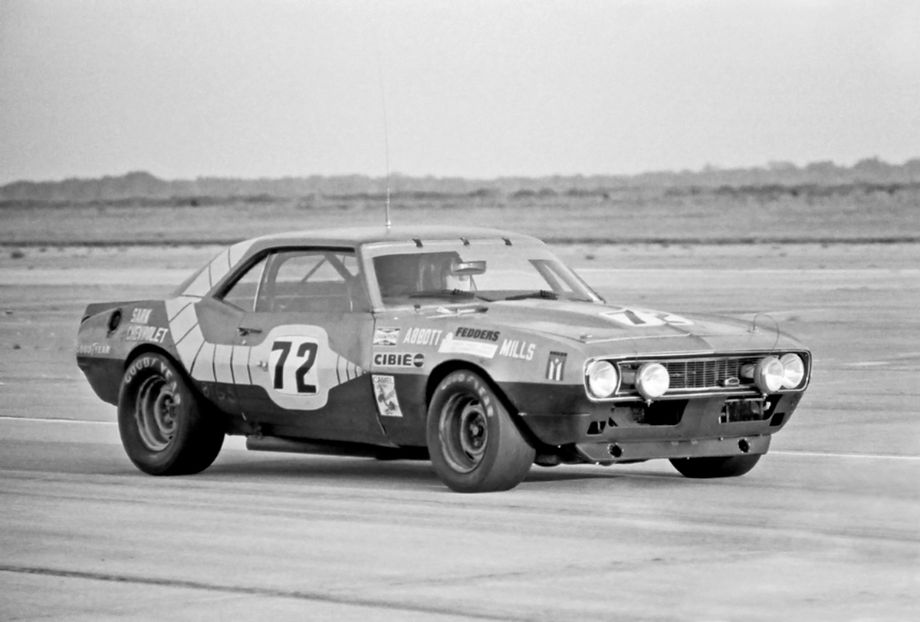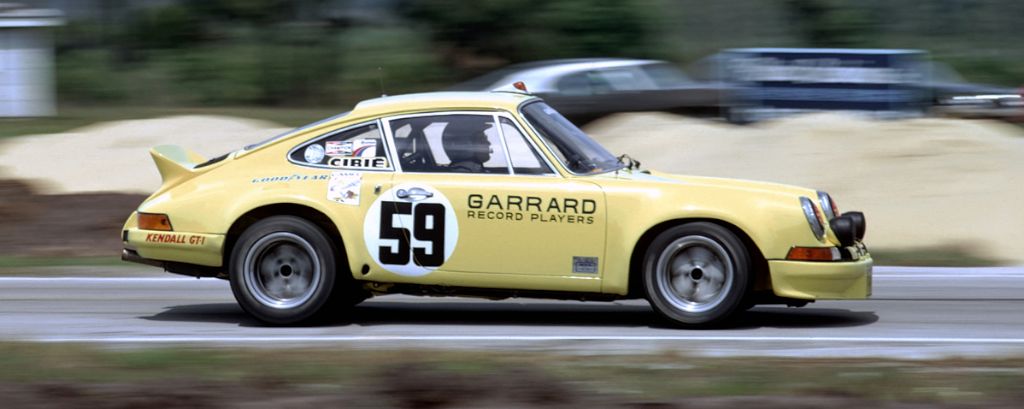Sebring Celebrates 40th Anniversary of IMSA at Sebring
By Louis Galanos | Photos as credited

On March 16, 2013 the Sebring Raceway and Mobil 1 held the 61st running of the 12-Hours of Sebring but also celebrated the 40th anniversary of the very first IMSA-sanctioned Sebring 12 Hour enduro.
The International Motor Sports Association (IMSA) came into being in 1969 under the leadership of John Bishop, the former executive director of Sports Car Club of America (SCCA), who left that organization after a falling out with the club’s leadership.
Bishop was contacted by NASCAR’s Bill France, Sr. who was looking to form a sanctioning body for road racing and saw in Bishop the man with the knowledge, experience and expertise he needed. With the financial backing of France, who at one time owned 75 percent of IMSA, Bishop created IMSA and even designed the logo for the organization.
In 1969 and 1970 IMSA put on a series of Formula Vee and Formula Ford races but many of those events didn’t draw the kinds of crowds expected to make a successful series so at the end of 1970 they went back to the drawing board and came up with a race series for FIA GT (group 3 & 4) and Touring (group 1 & 2) cars. Throughout 1971 this IMSA series for GT and Touring cars began receiving good reviews from fans and drivers alike.
For 1972 Bill France was able to work his magic with his NASCAR sponsors and got Camel Cigarettes to sponsor the IMSA GT series and the B.F. Goodrich Tire company to sponsor their IMSA small sedan (GTU) series.
The pivotal year for IMSA turned out to be 1973 and the place was the 1973 Sebring-Camel 12, The Camel GT Challenge at Sebring, Florida. Long known for being the premier sports car racing venue in North America the Sebring 12 Hour Grand Prix of Endurance had fallen on hard times and at the close of the 1972 event the Fédération Internationale de l’Automobile (FIA) pulled its certification of Sebring as an international automotive race.
From the late ’60s to the early ’70s the FIA constantly pressured Sebring founder, Alec Ulmann, to make what the FIA deemed to be necessary safety improvements to the track and needed creature comfort improvements to the spectator areas. Anyone who had attended races in those years would heartily agree that the “old lady” was showing her age. A charitable description of the track infrastructure back then as “racetrack primitive” would not be out of the question. Ulmann’s response each year to the pressure from the FIA was to announce to all who would listen that “…this is the last Sebring.”
[full_width_banners]
Well, push came to shove in 1972 after repeated promises from Ulmann that he would comply with the FIA edicts. Ulmann had even talked about major upgrades to the present facility and even floated the idea of moving the race to the Palm Beach area which almost happened in 1966 following the deaths of four spectators and a driver during the 12 hour race.
Only at the last minute did the FIA give Ulmann permission to hold the 1972 race based on his assurances that a new venue was in the works and would be ready for the 1973 World Sportscar Championship (WSC) season. Despite those assurances nothing ever materialized and Ulmann walked away from Sebring in 1972 and the FIA pulled its recognition of the event from its WSC calendar for 1973. In the eyes of the press the 1972 race was the last fully international event at the track and “The Last Sebring.”
No doubt a pall of doom and gloom settled in amongst Sebring’s many racing fans but the residents and city fathers of Sebring were hit particularly hard as they contemplated Sebring without “Sebring” and the vast revenues it generated each year for the city and business community.
Contemporary reports indicate that a group of local race fans, supporters and business leaders and, according to Autoweek “an angel”, came together to attempt to save the race. More about this “angel” later. In doing so they enlisted the help of Reggie Smith, the long-time Sebring Racing Secretary during the Alec Ulmann years.
As it turns out Reggie Smith was the right person to go to because he literally organized and ran the Sebring races for 17 years under the auspices of the Automobile Race Club of Florida (ARCF). The ARCF became the race organizing body for the race after the American Automobile Association (AAA) dropped out of racing following the tragedy at the 1955 24 Hours of Le Mans that took the lives of 83 spectators. It was the most catastrophic accident in motorsport history.
Despite initial misgivings, because time was fast running out before the annual date of the race, Reggie Smith decided to try and save the event and quickly formed the Sebring Automobile Racing Association (SARA) as the replacement for the ARCF. What he needed now was a sanctioning body willing to join with SARA in putting on a 12 hour race.
Reggie Smith was well aware of who John Bishop was and reports coming out of IMSA events indicated that they put on a more relaxed informal type of racing which is just what was needed at Sebring considering the state of the facilities in 1973. Initial talks between the two men seemed positive and John Bishop expressed his receptiveness to putting on the race. It was just what IMSA needed to raise its profile both nationally and internationally.
Sebring Celebrates 40th Anniversary of IMSA at Sebring Page Two
However, Bill France, Sr., expressed strong reservations on the financial commitment necessary for IMSA to take over one of the top events in North American racing. It would be a huge financial risk for the fledgling organization.
In just a few short weeks John Bishop, Reggie Smith and the “angel” were able to pull things together and get done what was needed to put the 12-Hours of Sebring on the 1973 IMSA Camel GT series calendar. While not an “…event of international stature, the 12 Hours of Sebring was nevertheless saved and a new era was on the horizon.” That sounds a lot easier than it really was because the tracks long-time insurance carrier, Lloyds of London, had abandoned them after the Automobile Competition Committee for the United States (ACCUS) declared the track to be unsafe. However, Bill France Sr. and his NASCAR insurer came to the rescue.
Next came the problem of prize money. Unless you can guarantee a healthy purse you will get few entries. Thankfully that previously mentioned “angel” had already stepped up to the plate with a guaranteed purse of $30,000. Plus he provided the money to allow planning to move forward in addition to making some needed minor safety changes to the course. Finally everything was in place to go racing.
On March 24, 1973, seventy-two cars took to the starting grid and they included almost twenty Corvettes, a similar number of Porsches including five Porsche Carreras, plus a number of Camaros, Mustangs and the occasional BMW, Mazda, Datsun, Alfa, MGB, Ford Escort, Dodge Colt and so on. There was even an AMC Gremlin in the running. It was a very competitive field with over a dozen cars capable of the overall win.
These were the cars that race fans could relate to. Gone were the big factory teams and prototypes from Europe, gone was the international press, gone was the wealthy Palm Beach crowd with their Ferraris, Maseratis, Lamborghinis and Rolls-Royces parked in the paddock. Also gone were the cute young ladies who traveled like camp followers to all the international races. They were replaced by cute college coeds who flocked to Sebring during Spring Break. It was a much more democratic environment with fans, race drivers, crews and course workers sharing space in the camping areas.
Press reports indicated attendance was half the previous year but in reality it was closer to seventy percent because the race actually made money. The crowds seemed to relate better to this new type of racing and if police reports are any judge the crowds were much better behaved than previous years. For some long-time veterans of Sebring it was a return to “real Sebring racing” like they had witnessed in the ’50s and early ’60s.
Before the green flag fell to start the race the Corvettes were given the odds-on chance of winning by the some fans, especially those in the Corvette paddock, because they were the fastest on the track and they were American made. Many hoped that this would be Corvette’s year at Sebring. During the first four hours of the race it looked like it might be as the Tony De Lorenzo – Steve Durst pole winning Corvette held the lead.
However they were in a fierce battle with the Corvette of Sebring veterans Dave Heinz and Jerry Thompson but the pace and notoriously rough Sebring course began to take its toll on the American cars with the Heinz/Thompson Corvette dropping out after completing 110 laps and the De Lorenzo/Durst Corvette retiring three laps later.


With the leading Corvettes out of the running first place was taken over by the Porsche 911 Carrera RSR of Peter Gregg, Hurley Haywood and Dave Helmick. Gregg and Haywood were fresh from their victory at the Daytona 24 one month earlier in a Brumos Porsche 911 Carrera RSR.
For the rest of the race the Gregg/Haywood/Helmick car maintained their lead but had to fight off challenges from the Porsche 911 Carrera RSR of Elliott Forbes-Robinson and Gray Egerton and during the last five hours from Michael Keyser and Milt Minter in another Porsche 911 Carrera RSR who finished second. Only the hard-driving Corvette of John Greenwood, Ron Grable and Mike Brockman prevented a clean sweep for Porsche. They finished in third place. Coming in first in the small sedan class, but seventh overall, was the Porsche 911S of Steve Behr, Don Lindley and Brian Goellnicht.


While the national and international press gave short shrift to the IMSA Sebring Camel-12 race, it was a remarkable comeback for an event that was given up for dead at the end of 1972 and it was just the beginning of Sebring’s comeback. None of this would have been possible except for the dedication and support of a lot of fans of Sebring; chief among them was that “angel” mentioned earlier. He was none other than Corvette legend, John Greenwood. John got on board early on in saving Sebring through Bill France, Sr. France had a favorable opinion of John because Greenwood financed and promoted a USAC Indy car event and a NASCAR race at Michigan International Speedway (MIS) in 1972. That event was well received and all the bills were paid and Greenwood remembers that France approached him to help finance and save Sebring.
John decided to go for it, withdrew money from his bank, flew to Florida and deposited it in the race account. John trusted Reggie Smith to run things at Sebring but he also had Frank Cipelli watch over the handling of the race, but without being obstructive. Frank was not only John’s first race driving instructor but also General Manager for MIS and John trusted him to protect his investment. Being the Sebring “angel” also meant that John was burdened with paying the ticket takers, the track security, the contractors for fuel and food, as well as the seven secretaries who handled advance ticket sales. Fortunately for him the race made money.
In the weeks prior to the race John organized his co-drivers, Ron Grable and Mike Brockman, into a “troupe of promoters” that traveled the state of Florida advertising the race on college and university campuses with an information table and a race car. At one point, in the Orlando area, they were joined by none other than the great Stirling Moss.
The only pothole in the road back for Sebring was the Arab Oil Embargo of 1974 that resulted in a national gas shortage and led to the cancellation of the 24 Hours of Daytona as well as the 12 Hours of Sebring. Fearing another cancellation of Sebring in 1975 “angel” Greenwood stepped in as promoter and was able get enough sponsorship for the race to be run. For the second time in three years the race was saved from the scrap heap of history. It continues today, “…as the most popular sports car race in America and one of the most closely watched in the international scene.”
1973 IMSA Sebring Camel 12 Hours – Photo Gallery










The unauthorized use and/or duplication of any editorial or photographic content from sportscardigest.com without express and written permission from the publisher is strictly prohibited. Excerpts and links may be used, provided that full and clear credit is given to sportscardigest.com with appropriate and specific direction to the original content.
1973 IMSA Sebring Camel 12 Hours – Photo Gallery Page Two










The unauthorized use and/or duplication of any editorial or photographic content from sportscardigest.com without express and written permission from the publisher is strictly prohibited. Excerpts and links may be used, provided that full and clear credit is given to sportscardigest.com with appropriate and specific direction to the original content.
1973 IMSA Sebring Camel 12 Hours – Photo Gallery Page Three










The unauthorized use and/or duplication of any editorial or photographic content from sportscardigest.com without express and written permission from the publisher is strictly prohibited. Excerpts and links may be used, provided that full and clear credit is given to sportscardigest.com with appropriate and specific direction to the original content.
1973 IMSA Sebring Camel 12 Hours – Photo Gallery Page Four










The unauthorized use and/or duplication of any editorial or photographic content from sportscardigest.com without express and written permission from the publisher is strictly prohibited. Excerpts and links may be used, provided that full and clear credit is given to sportscardigest.com with appropriate and specific direction to the original content.
1973 IMSA Sebring Camel 12 Hours – Photo Gallery Page Five









The unauthorized use and/or duplication of any editorial or photographic content from sportscardigest.com without express and written permission from the publisher is strictly prohibited. Excerpts and links may be used, provided that full and clear credit is given to sportscardigest.com with appropriate and specific direction to the original content.
1973 IMSA Sebring Camel 12 Hours – Photo Gallery Page Six








The unauthorized use and/or duplication of any editorial or photographic content from sportscardigest.com without express and written permission from the publisher is strictly prohibited. Excerpts and links may be used, provided that full and clear credit is given to sportscardigest.com with appropriate and specific direction to the original content.
For Additional Reading:
Sebring: The Official History of America’s Great Sports Car Race, Ken Breslauer, pages 119-121
Competition Press & Autoweek, February 24, 1973
IMSAblog, imsahistory.com Alexis Gousseau
sebringraceway.com
ucapusa.com
racer.com
[Source: Louis Galanos]











Great read Lou…as always! Loved the photo gallery too.
Having been to just about every Sebring from 1961, I found the 73 non FIA version a little anti-climatic. I enjoyed the thunder of the 427 Corvettes, but was most impressed with Porsche’s efficiency and consistency. We’d become so accustom to being so overwhelmed by the brutal speed of Ferrari, that adjusting to a Porsche GT as the dominant car took some getting used to. Off subject a bit; I had missed in subsequent years from 1966, The warehouse straight and Webster turns. I had spent many enjoyable hours over many a year watching Phil Hill coming through Websters opposite locking with one hand arrogantly affixed to his chin and the other open palm to the wheel, all done wearing that silly half helmet. For me seeing the present day pasteurized version of a shortened Sebring course with the modern facilities and the rigid conformity to prescribed specifications, makes that old make shift course with it’s glaring imperfections and crude informality, that much more memorable.
What a great story on Sebring 1973! The quality and variety of photos was outstanding. It really bought back some great memories of great times!
Currin:
Elliott likes seeing “his car” featured here too.
send me an e-mail back
Thanks for sharing great memories – the photos are the best!! I never knew about John Greenwood’s vital contribution to the survival of this classic race so he deserves a special place in racing history – wonder if Bill France Sr. have come through with the needed financing?
Well, once again Lou, or should one call you by your correct title “Mr Sebring”… You have done it again, great stuff, I´m sure we haven´t read the last of your historic recollections of this great race. More please… Cheers Graham
Thank you Lou, another great one, well done!
Another great article and photos. It’s been years since I’d heard these names, many who I drove with, and some who are no longer with us. John and Peggy Bishop and the IMSA entourage were regular customers at the San Remo Restaurant. Guido Levetto
Great memories….great times….great racing…Mario
Wonderful Story, Great Photos! I met Fast Phil in 1974 and enjoyed much more wonderful time in his #99 racing endeavour! Treasured Memories, Indeed!!
I had no idea that Bobcor sponsored anything that wasn’t an Alfa Romeo. So, I was completly surprised to see their name on John Buffum’s Ford Escort. A great effort, as always, Lou.
Well-written as usual, Lou. It seems that I’ve made that comment before about your articles. Thanks, too, for the opportunity to provide photos for this story. Today’s fans can only imagine what that place was like back then. I’ve nearly frozen my tail off, been burned almost to a crisp and half choked to death on campfire smoke when there wasn’t a hint of a breeze. Calling it crude back then would have been a compliment.
Wonderful report, Lou. Made me miss “racetrack primitive”.
Dave
I want to thank Louis for another terrific account of racing’s past. And I appreciate his acknowledging John’s involvement. I still remember being impressed that big brother was dealing with Bill France and John Bishop. I’ve been calling John “angel (of Sebring)” since we read it. If you haven’t already, I recommend all of Louis’s contributions to Sports Car Digest, they breathe vivid life back to that golden period of racing.
Great work Louis. It really brought back that period. I felt that losing the Sebring event would hurt the credibility of American road racing, so it was worth the financial risk. Plus, we were already thinking of future changes to the facility that would bring back the FIA and also give a venue for runnig the INDY cars in Florida. Oh yea, tell Burt to quit calling me “angel”.
The pics are amazing and especially the 911 which is catching fire ! Incredible ! Congratulations from Paris !!
Wow, a race where the cars in the paddock were more interesting than those on the track. Not a great juxtaposition.
I have a question. Why is the Bumos 911 yellow in this race while at the Daytona 24 just a couple of months earlier it was in its iconic livery.
Just curious.